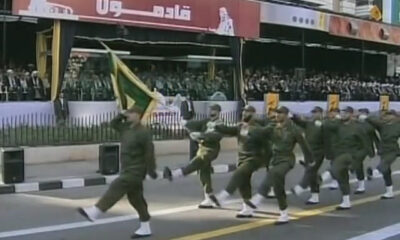Civilization
Ukraine Can No Longer Win
The fall of Avdiivka to Russian forces makes abundantly clear: regardless of how anyone feels about it, Ukraine cannot win.

Reassessing American Aid After Avdiivka
As the second anniversary of Russia’s full-scale invasion of the country to its west nears and the latest aid package for Ukraine stalls in Congress, we must be clear-eyed about the future: there is no path for Ukraine to win this war. American support will not change this reality.
Early Success: Ukraine Defies Expectations
Two years ago, the Ukrainian Armed Forces defied expectations immediately. Days before Russia’s massive combined arms incursion at dawn on February 24, 2022, Chairman of the Joint Chiefs of Staff Mark Milley spoke for the U.S. military when he predicted to Congress that Kyiv would fall within 72 hours. Many military analysts similarly predicted the Russian Armed Forces would quickly route the overmatched Ukrainian Armed Forces. American leaders encouraged Zelensky to leave the country lest Russian troops assassinate him.
These projections of immediate success for Russia misread the progress Ukrainian troops have made in capability and readiness since Russia’s 2014 annexation of Crimea. They also overestimated the Russian forces’ readiness, air superiority, and command cohesion.
Against All Odds: Unrealistic Expectations
One year ago, the people of Ukraine saw encouraging signs in their gruesome war with Russia from almost every corner. A year into Russia’s massive invasion, Ukrainian forces were bloodied but held on to territory in the east in defiance of most expectations. Successful counteroffensives allowed Ukraine to regain territory in the south. Ukrainian president Volodymyr Zelenskyy defiantly declared the coming year one of “our invincibility.” American aid into the country offered a king’s ransom in artillery and anti-tank weapons through the Ukraine Security Assistance Initiative, and the flow seemed unceasing. Inspired by Ukraine’s stunning success against the much larger and more advanced military, the West galvanized behind Volodymyr Zelensky and his troops. Tragically, all these indicators led to unrealistic expectations.
Reality Sets In: A Brutal Slog
Today, the situation is grim. The once dynamic fighting has slowed to a cruel slog – one that inures to Russia’s favor as Ukraine runs low on troops and munitions while Russia maintains both in plenty. The long-planned, high-risk, months-long Ukrainian spring 2023 counteroffensive failed, with Ukraine unable to regain any territory seized by Russia. Support for Zelinsky – in Ukraine and the West – has finally slipped. American aid is logjammed in Congress, and the U.S. seems tired of funding the war.
Over much of the past two years, following those predictions of immediate Russian victory, analysts and policymakers have gone in the other direction with a new set of misjudgments: that the Russian Army is a paper tiger. That the generals will turn on Putin. That Ukraine will bleed Russia out in Donbas.
No Path to Victory: Russia has the Momentum
The reality two years in is that there is no path to victory for Ukraine – not in the sense of pushing Russian troops back to the pre-February 2022 lines of control. After the Ukrainian troops abandoned Avdiivka – the most significant loss or gain by either side in nine months – following some of the war’s heaviest fighting, almost all advantages accrue to Russia. The seizure of Avdiivka does not materially change the war, but it does change the momentum. Moscow can throw mass in terms of bodies, tanks, artillery, and drones at the exhausted Ukrainian forces until they crack. Ukraine is exhausted and outnumbered and struggling to recruit new troops. The best Ukraine can do now is fight Russia to a negotiated settlement that allows sovereignty, territorial integrity, and security from another Russian invasion. Even these provisions now seem unrealistic.
After initial setbacks at the onset of the invasion, the Russian military now displays the resolute determination initially witnessed by the other side. Russian generals have adapted to Ukraine’s offenses after initial setbacks. Russian commanders are now building the kinds of defenses in depth that Ukrainian forces struggle to fight through. Russian ground forces now routinely defeat Ukraine’s drones. Russia’s formidable arsenals of attack helicopters, drones, and mines pound Ukraine while the Ukrainian troops resort to rationing artillery shells and long-range rockets.
In the first year after the full-scale Russian invasion – February 2022 to February 2023 – Ukrainian troops overcame massive disadvantages in technology and mass. They did so mainly with American Javelins, Stingers, and Multiple Launch Rocket Systems. During that period, Ukraine had largely bipartisan support in D.C. Throughout the following year – February 2023 to today – American aid – including dozens of tanks, more than a hundred Bradley Fighting Vehicles, and more than a hundred Strykers – kept Ukraine in the fight. During this period, support among Republicans in Congress began to wane. Even if the House approves the current proposed aid package, the flow of weapons is coming to a close. Without a continuing stream of those weapons, Ukraine will ultimately fall. Even the F-16 fighter jets the U.S. will ship to Ukraine in the coming months will not turn the tide. F-16s require long, smooth runways; the fighter aircraft will struggle to land and take off on Ukraine’s bombed-out runway.
Russia also has the advantage of time. While Putin can lead Russia along a single strategic trajectory regardless of the length of the war, the United States is subject to the whims of democracy: presidents and members of Congress change hands, voters grow weary of supporting other countries, and policies change.
Geopolitics change fast. The upheavals in the world over the past two years distracted the U.S. from supporting Ukraine. Hamas’s stunning and savage infiltration into Israeli territory last October and Israel’s gruesome retaliation became the primary international focus of the White House and Congress. Iran began a low-grade war with the U.S. through its proxy forces in Iraq and Syria. China promised to reunify with Taiwan. All these cataclysms require attention and money – elements in limited supply – otherwise spent on Ukraine.
An Uncertain Future: Working Against Time
Adding to the uncertainty is the looming U.S. Presidential election this year. Donald Trump, the most prominent challenger to President Biden, harbors a deep distrust of NATO, underscored by recent remarks suggesting leniency towards Russia’s actions against non-compliant NATO members. Given all these headwinds and the enormous strategic stakes involved, it is critical to consider the pathways forward in light of the shifting dynamics.
In considering an aid package to Ukraine, DC policymakers and their constituents must assess how long the cash and weapons will continue to flow and toward what end. Getting to a favorable – or at least even – negotiated settlement will take more than a year of fighting. Putin has no incentive to stop fighting and every incentive to continue pushing and waiting for his adversaries to the west run out of troops and munitions, and policy makers in the U.S. run out of patience.
None of this is fair to the people of Ukraine, who have placed their hopes of sovereignty on American commitment. It is, however, the tragic reality of the situation. The $60 billion aid package held up in Congress will not significantly change the future. This fight is a long haul that will require additional aid. The spigot will close at some point – perhaps soon – turning off aid and sealing Ukraine’s fate.
This article was originally published by RealClearDefense and made available via RealClearWire.
Joe Buccino is a research analyst at the Defense Innovation Board, a former communications director at U.S. Central Command, and a retired U.S. Army colonel with five deployments to the Middle East during his military career. He served as the communications director for the NATO support mission in Europe from February to November 2022.
-

 Executive4 days ago
Executive4 days agoSecret Service chief gets no solace
-

 Civilization5 days ago
Civilization5 days agoBiden drops out of race
-

 Executive2 days ago
Executive2 days agoWaste of the Day: Louisville Taxpayers Pay Nearly $600,000 For Empty Building’s Maintenance, Security
-

 Guest Columns4 days ago
Guest Columns4 days agoFear Itself: Democrats’ Favorite Strategy Caused Their Current Chaos
-

 Executive3 days ago
Executive3 days agoWhere is Joe Biden – or Jill?
-

 Executive1 day ago
Executive1 day agoWaste of the Day: Throwback Thursday: Cities Used Crime Prevention Funds on Soccer Games, Paper Shredding
-

 Civilization4 days ago
Civilization4 days agoBuild Iron Dome in the United States To Prepare for Israel’s Worst Day
-

 Executive2 days ago
Executive2 days agoFacile and politically motivated suggestions










